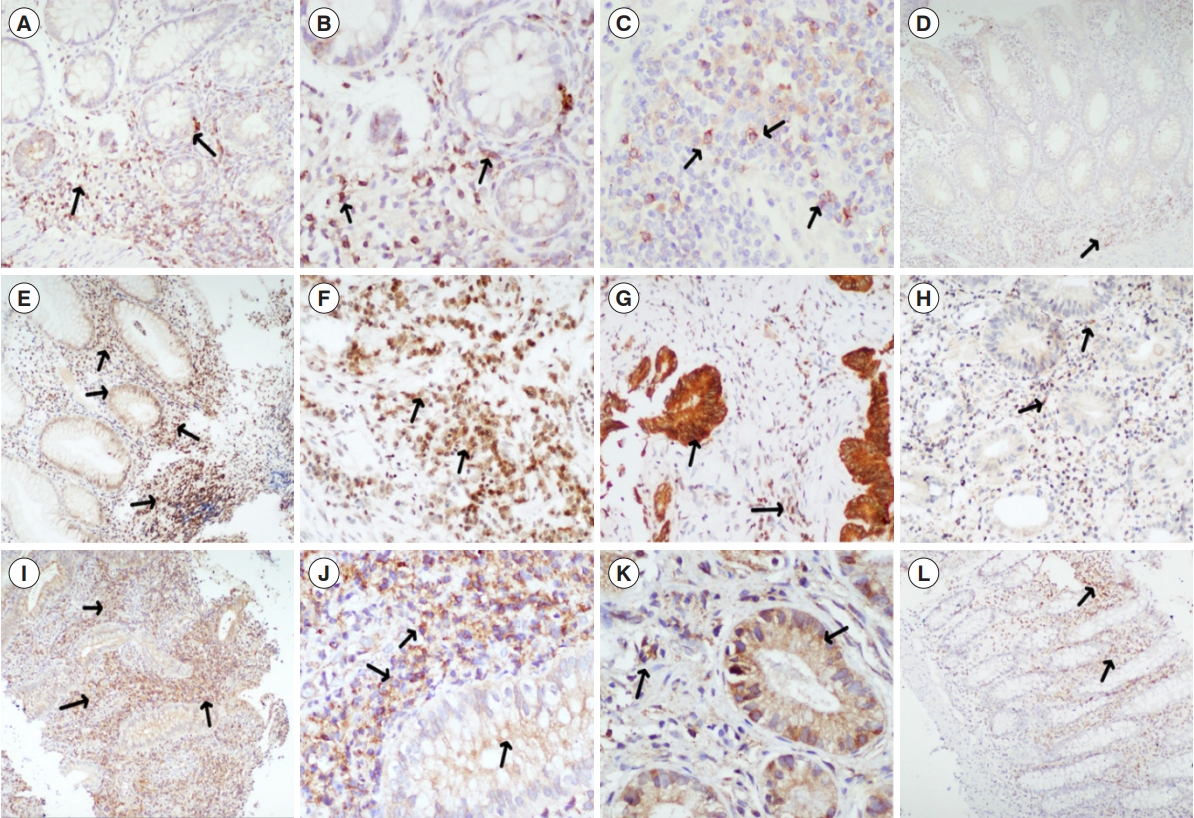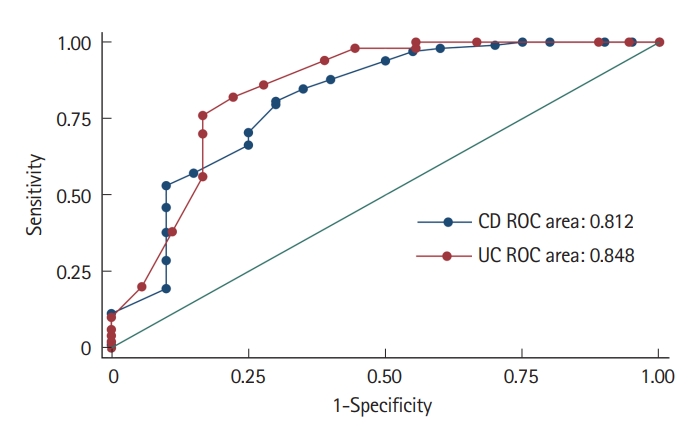INTRODUCTION
Anti-tumor necrosis factor (anti-TNF) agents represent the standard of care for moderate to severe inflammatory bowel disease (IBD). However, approximately one-third of patients receiving anti-TNF therapy develop primary nonresponse (PNR), and a significant proportion (up to 50%) become refractory over time (secondary loss of response, SLR) [
1]. Gisbert and Panés [
2] estimated that the annual risk for loss of response to infliximab is ~13% per patient-year of treatment.
Hence, predictive biomarkers are warranted which can stratify patients according to their underlying disease biology to improve therapeutic success. Various factors predicting response to anti-TNF have been described, including clinical predictors like disease duration, location, and phenotype; severity of disease; biochemical parameters like hemoglobin, C-reactive protein (CRP), and albumin; treatment-related like previous anti-TNF exposure and combination therapy; and previous surgery [
3,
4]. Among potential mucosal targets and biomarkers, oncostatin M (OSM), OSM receptor (OSM-R) and interleukin-7 receptor (IL-7R) have gained interest in the past few years [
5,
6].
With the rising overall burden of IBD in India and other Asian countries, need for anti-TNF agents is also increasing [
7]. IBD is as aggressive in India as it is in West, and it must be treated similarly. There is a higher risk of tuberculosis reactivation with anti-TNF agents, however, this risk in endemic areas can be considerably mitigated by using a stringent screening and liberal chemoprophylaxis approach [
8,
9]. The evidence on predictors of response to anti-TNF agents in these regions is scarce. Moreover, as yet, adalimumab drug levels and antibody tests are not available and access to infliximab drug and antibody levels is very restricted in these regions. Hence in such challenging circumstances managing anti-TNF therapy without access to drug pharmacokinetics necessitates the urgency for evaluating other clinical and biochemical factors which can guide the clinician in planning therapy. Further, the role of therapeutic drug monitoring is limited during the induction phase. Hence, the present study aimed at identifying clinical, biochemical, and molecular markers that predict PNR at week 14 after induction dosing and SLR at week 52 in patients with IBD.
DISCUSSION
This study has evaluated clinical and molecular predictors of response to anti-TNF therapy in Asian patients with IBD. Predicting anti-TNF therapy success in areas without access to drug pharmacokinetics as well as molecular predictors have not been described for any Asian cohort as yet and this study fulfils that gap. Low serum albumin prior to anti-TNF therapy initiation significantly predicted PNR in UC patients and PNR as well as SLR in CD patients. Mucosal markers of PNR were high stromal OSM and OSM-R expression in UC and high stromal IL-7R expression in CD patients.
This study highlights foremost that only 2.7% of patients (186/6,802) had access to anti-TNF therapy highlighting the resource gap in this region. Phenotypic descriptive studies have shown that IBD in India is behaviorally similar to IBD patients from the West [
8], yet the dismal rate of usage of anti-TNF therapy suggests lack of access to high-cost medicines as universal health insurance coverage is absent. And in line with that is the absence of adalimumab drug and antibody level measurement facilities and restrictive access to drug pharmacokinetic measurements of infliximab. Hence, the research gap in such regions is to evaluate if easily measurable clinical and biochemical factors can be helpful in such situations and wherein lies the significance of this study.
Amongst the clinical and biochemical factors, only higher baseline CRP and lower albumin were significantly associated with PNR in UC (on univariate analysis), however, only albumin retained significance on multivariate analysis. Patients with active inflammation, characterized by elevated levels of inflammatory biomarkers such as CRP are less responsive to anti-inflammatory therapy as seen in previous studies [
3,
15], where a high baseline CRP (> 5 mg/L) was an independent predictor of colectomy in UC patients using infliximab [
15]. High CRP reflects a higher inflammatory load, contributing to faster drug elimination and reduced drug response. Higher baseline CRP levels have also been associated with nonresponse in patients with CD, as suggested in a retrospective cohort of 148 CD patients, where high baseline CRP levels predicted PNR [
16]. However, higher CRP levels could also select patients with active disease who are likely to respond to anti-TNF therapy as documented in a real-life cohort of 438 CD patients, where an elevated CRP was associated with a 3-fold higher response rate to induction therapy with adalimumab [
17]. However, no such significant association between baseline CRP levels and nonresponse (or response) was seen in our cohort of patients with CD. CRP levels are determined by multitude of factors such as genetic polymorphisms, ethnicity, and sociodemographic and environmental variables, body mass index being one of the most important correlates accounting for 15% variation in CRP [
18]. As per World Health Organization Global Health Observatory 2016 estimates, body mass index of Indian adults is lower than Western counterparts, which could account for low CRP in Indian population, and hence lack of association of CRP with TNF response. A recently published multicenter study on acute severe UC demonstrated similar observations with CRP in the Indians being lowest as compared to British and Australians [
19].
Albumin plays a cardinal role in drug transport and metabolism by binding several drugs with a high affinity, thereby slowing their elimination rates [
20]. Low albumin concentration is a marker of underlying pathologic processes, such as malnutrition and inflammation, and has been linked to poor outcomes in many health disorders [
21]. Here, we emphasize the significance of serum albumin as a biomarker in predicting nonresponse to anti-TNF therapy. Anti-TNF titers are negatively influenced by low serum albumin levels, as demonstrated in a study of 720 patients by Fasanmade et al. [
22], where higher serum albumin maintained a higher infliximab concentration, lower clearance, and longer half-life than patients with lower serum albumin. In the present study, PNR was documented in both UC and CD patients with low baseline serum albumin. Moreover, lower baseline albumin was also associated with SLR in CD patients. Like our study, several studies have correlated serum albumin with anti-TNF drug levels and responses in patients with both UC and CD. In a recent study, patients with acute severe UC had significantly lower infliximab levels compared to those with moderate UC during the induction phase, which significantly correlated with albumin levels [
23]. In another study of 285 patients with steroid-refractory UC treated with infliximab, baseline albumin ≥ 3.5 g/dL was an independent predictor of colectomy-free survival [
3]. Similarly, in a study of 64 UC patients, and in the PANTS study (UK-wide, multicenter, prospective observational cohort study in CD), low baseline serum albumin predicted anti-TNF nonresponse (
P<0.05) [
13,
24]. The relationship between serum albumin and anti-TNF response, mechanistically can be explained by the common mechanism which catabolizes both albumin and monoclonal antibodies (which are IgG immunoglobulins), namely the neonatal Fc receptor [
22]. These findings suggest that improving albumin levels can increase the anti-TNF response, and same has been corroborated by improved anti-TNF response in combination with exclusive enteral nutrition [
25].
Among other clinical predictors, postoperative recurrence (PNR), EIMs (SLR) and adverse events (PNR) predicted nonresponse in CD on univariate analysis. Lack of association between adverse events and response in UC could be due to low sample size. Postoperative recurrence indicates an aggressive disease phenotype, and thus poor response to anti-TNF, similar findings were demonstrated in a Belgian study [
3]. Similarly, presence of EIMs would also indicate higher inflammatory burden leading to loss of response. Adverse events would require intermittent or permanent withdrawal of anti-TNF therapy thereby leading to higher nonresponse. Other factors which demonstrated a trend but were not significantly associated included lower age at disease onset, smoking, and concomitant steroid use (for PNR); and presence of EIM and late age at anti-TNF initiation (SLR) in UC, and past history of antitubercular treatment (both PNR and SLR), higher baseline CDAI (PNR), perianal disease (SLR) and absence of smoking in CD (SLR) (
Tables 1 and
3). Most of these factors have been heterogeneously associated in other studies and either indicate higher inflammatory burden at anti-TNF initiation or an aggressive disease course [
26]. A reverse association between smoking and loss of response with anti-TNF therapy could be due the lack of association between smoking and disease course in CD as demonstrated in earlier studies from India [
27]. Anti-tubercular therapy has been associated with aggressive disease course in CD [
28], and the same factor could account for the trend observed in present study. Low sample size could account for lack of significance.
OSM, a member of the IL-6 family of cytokines which shares common gp130 receptor subunit, is one of the most strongly and consistently expressed cytokine in the colon of IBD patients when compared to healthy colonic mucosa [
5], and enhances intestinal inflammation by upregulating the expression of chemokines, cytokines and adhesion molecules on gut-resident stromal cells. In a landmark study, analysis of more than 200 patients with IBD demonstrated that a high pretreatment OSM level was strongly associated with failure of anti-TNF therapy [
5]. Similar results were seen in our study, where higher baseline OSM stromal levels predicted PNR at 14 weeks in patients with UC. Due to the small sample size of patients with molecular markers, OSM and OSM-R could not be included in multivariate analysis.
IL-7 regulates T lymphocyte homeostasis and is primarily produced by epithelial and stromal cells. IL-7R regulates the expression of both pro and anti-apoptotic BCL-2 family members and activates the PI3K and JAK/STAT pathways to provide proliferative and antiapoptotic signals [
29]. A recent study demonstrated heightened expression of the IL-7R and the IL-7 dependent signaling pathway in the inflamed colon of IBD (120 UC and 8 CD) patients nonresponsive to anti-TNF therapy [
6]. In the present study also higher baseline IL-7R expression on stromal cells in CD patients predicted PNR at 14 weeks. In UC, although expression of IL-7R was numerically higher in patients with PNR, the difference was statistically non-significant.
The use of anti-TNF is increasing in Asia with the rising disease burden of IBD. However, because of their prohibitive cost and increased chances of adverse events, it is important to develop the predictors of response to anti-TNF in patients with IBD from India and similar countries. This study is the first such attempt from Asia and lays a platform for further larger studies toward this goal. Limitations include retrospective design and relatively small sample size, and therefore our results require further validation in larger cohorts. More objective endpoints, such as mucosal healing on endoscopy and transmural healing on cross-sectional imaging, were not investigated; instead, clinical endpoints were employed to identify nonresponse. Molecular markers-OSM, OSM-R, and IL-7R were examined in relatively few biopsy specimens; hence, these variables could not be included in multivariate analysis. AntiTNF levels and antibody levels are crucial indicators of nonresponse, but we were unable to evaluate these indicators.
In conclusion, our findings suggest low serum albumin as the most important predictor of nonresponse to anti-TNF therapy in patients with IBD when drug pharmacokinetic measurement is unavailable. Molecular predictors such as stromal OSM, OSM-R, and IL-7R pathways provided a signal, and will require further validation in studies with larger sample sizes.












